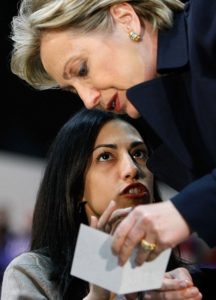You may recall that I once made a point about the importance of knowing what should be considered classified even if the document does not have a classification noted on it. I cited Hillary Clinton’s itinerary as an example.
The movements of the secretary of state, including her travel schedule, where she will be staying and who she will be meeting with, where and when would be valuable to a bad actor.
“Even if information is not marked classified in an e-mail, participants who know, or should know that the subject matter is classified, are still obligated to protect it,” said FBI Director James Comey.

Clinton aide Huma Abedin was among those deposed by Judicial Watch. E-mails show she was extremely lax with sensitive information. (getty image)
During a document dump, we learned that Clinton aide Huma Abedin was also loose with sensitive information. During a 2009 conference in Trinidad and Tobago, an aide e-mailed Abedin to ask for Clinton’s day book binder, which is thought to be private. “Yes. It’s on my bed in my room,” Abedin responded, “U can take it. My door is open. I’m in the lobby.”
Then there was Clinton’s handling of e-mails containing drone targeting. Much more serious.
So the drip, drip, drip of information concerning Clinton and her closest aides continues as a daily reminder of someone unfit to be president.
(If you would like a free subscription to kramerontheright, simply scroll to the bottom of the column at right.)





